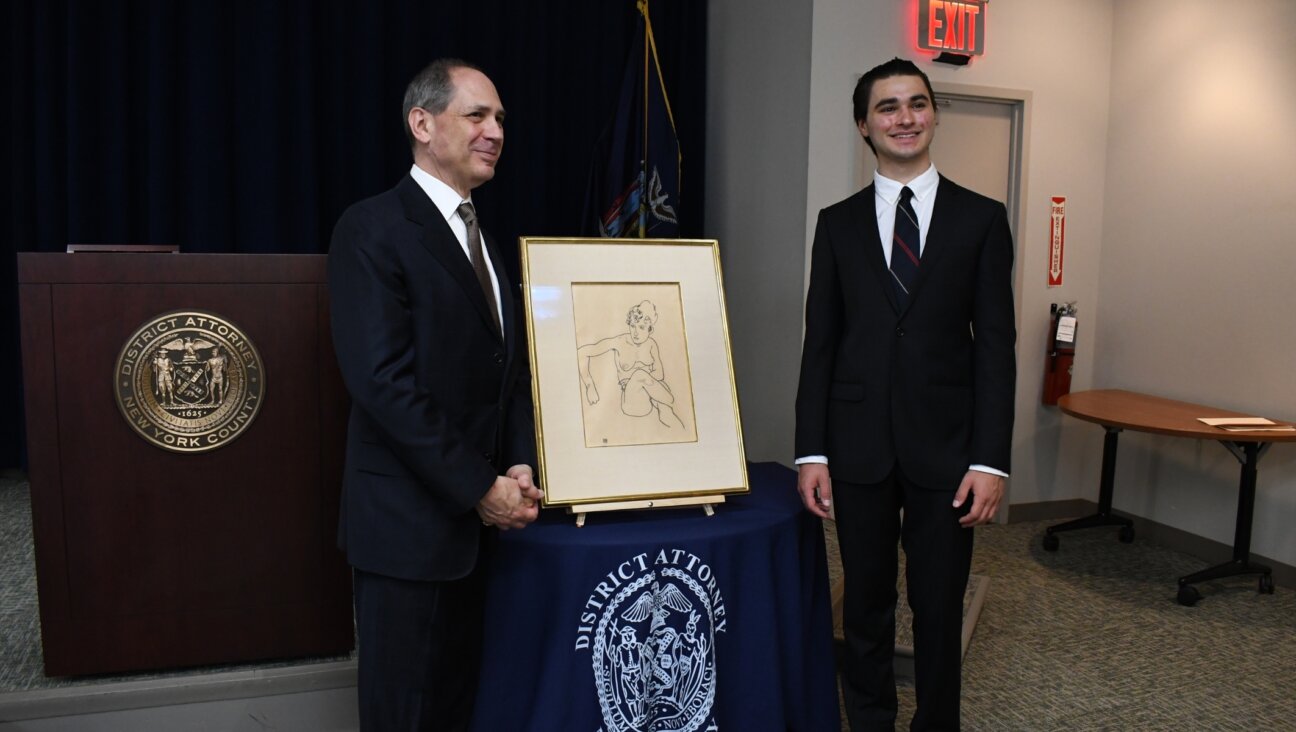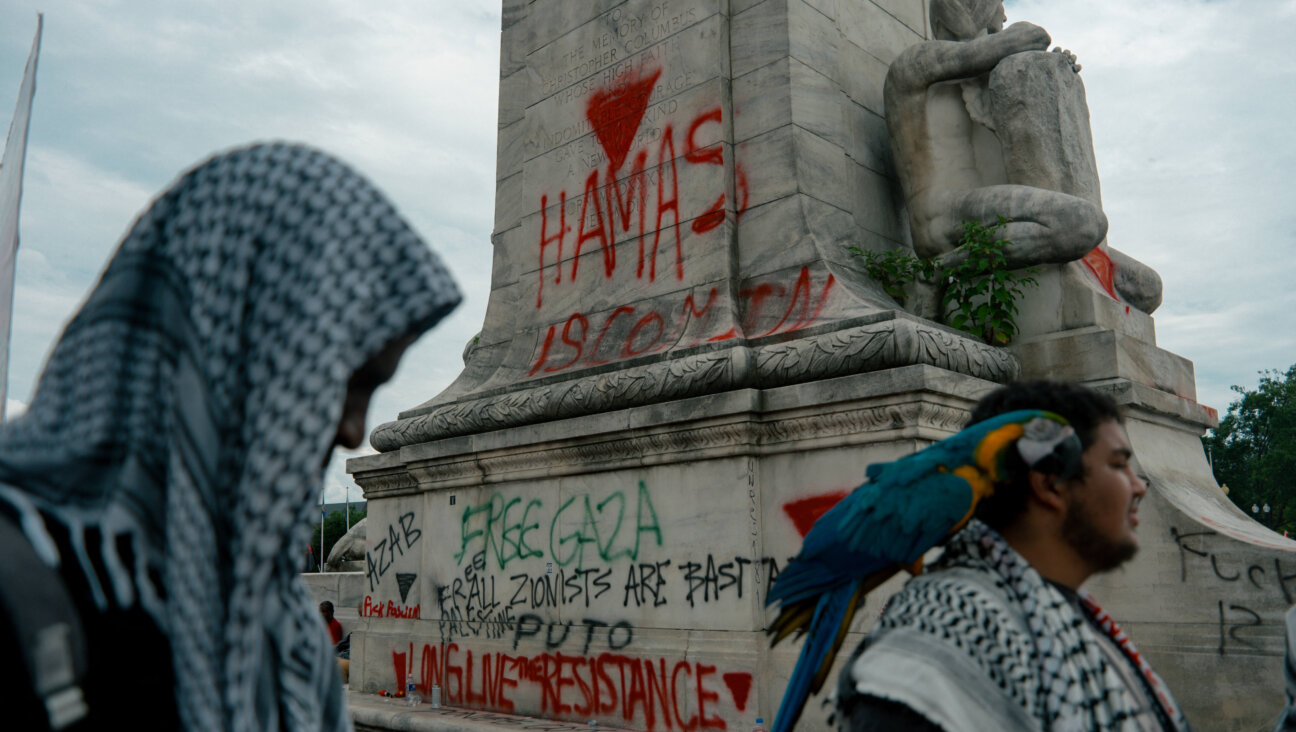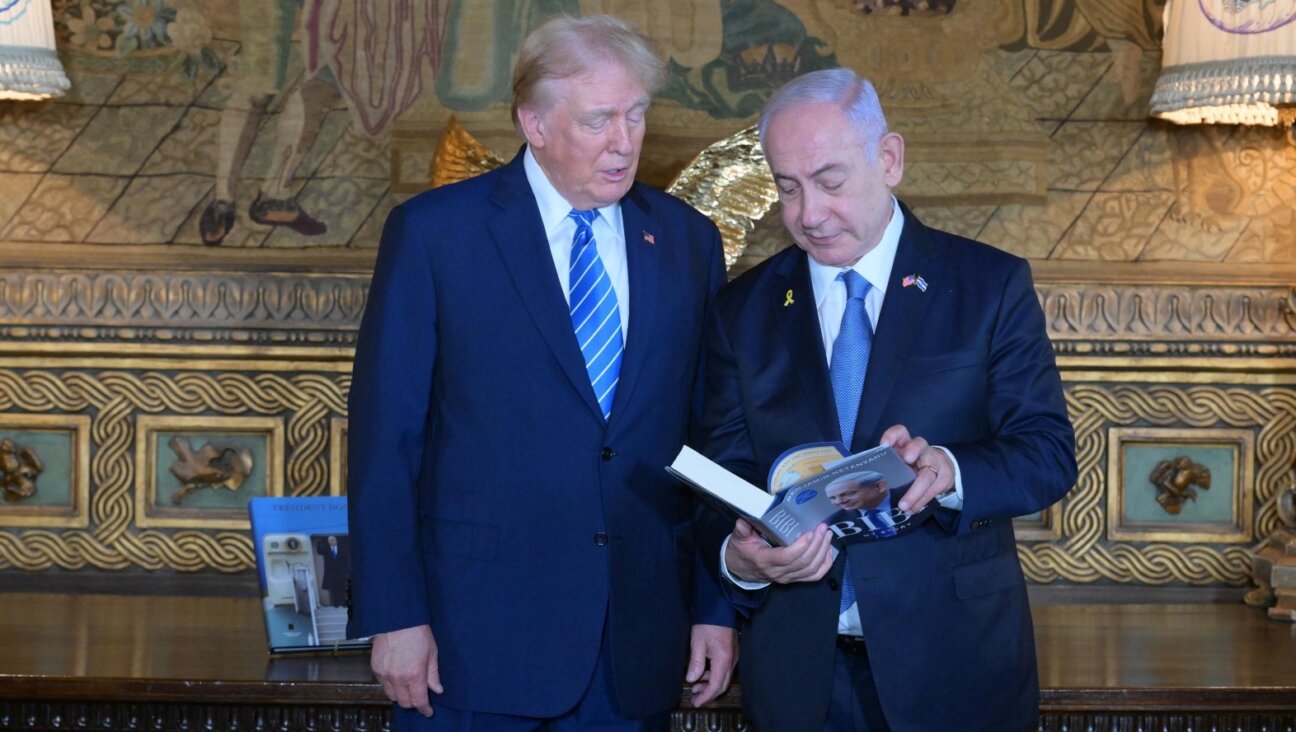Pandemics have always incited anti-Semitism. Here’s the history you need to know.

Coronavirus in New York. Image by Spencer Platt/Getty Images
Every pandemic begins with a terrifying moment in which it seems impossible to explain what is happening.
Often, whoever is considered the “other” in society is blamed, a scapegoating we see happening here and now.
President Trump’s administration has drawn criticism for periodically insisting on calling the coronavirus “the Chinese virus,” a move many see as racist. In the first weeks of the American crisis over coronavirus, white nationalists tried to deliberately spread the coronavirus to Jews, as detailed in a recent FBI alert. Earlier this week, protesters in front of the Ohio Statehouse carried signs directly blaming Jews for plague, depicting Jews as rats — drawing condemnation from Governor Mike DeWine. They’re not alone: as Moshe Kantor, president of the European Jewish Congress, noted in remarks on anti-Semitism this week, “Since the beginning of the COVID-19 pandemic, there has been a significant rise in accusations that Jews, as individuals and as a collective, are behind the spread of the virus or are directly profiting from it.”
As a public service during this pandemic, the Forward is providing free, unlimited access to all coronavirus articles. If you’d like to support our independent Jewish journalism, click here.
Meanwhile, some lawmakers have compared coronavirus restrictions to Nazi laws: Idaho State Representative Heather Scott, for instance, compared coronavirus lockdowns to Nazi Germany and the state governor to “Little Hitler.” “I mean that’s no different than the Nazi Germany, where you had government telling people, you are an essential worker or non-essential worker and the non-essential workers got put on a train,” she said.
All of this can feel medieval.
In some ways, it is. On the very first page of his sweeping book “Anti-Judaism: The History of a Way of Thinking,” the historian David Nirenberg wrote that “medieval Europeans invoked Jews to explain topics as diverse as famine, plague, and the tax policies of their princes.” Kantor, at least, sees that perspective reviving today. “The language and imagery used clearly identifies a revival of the medieval ‘blood libels’ when Jews were accused of spreading disease, poisoning wells or controlling economies,” he said.
But part of the current rise in anti-Semitism has to do with a specifically American story of blaming and retaliating against minorities in response to a public-health emergency, as physician and medical historian Howard Markel chronicles in his book “Quarantine! East European Jewish Immigrants and the New York City Epidemics of 1892.”
Here’s what happened in the past, as scared people tried to “explain” a pandemic — and a look at why that history matters now.
The Black Death
There is no way to overstate the impact of the Black Death, which killed at least 25 million people between 1347 and 1352. That pandemic also gave rise to “the most monumental of medieval Jewish persecutions,” wrote Samuel K. Cohn Jr., professor of medieval history at The University of Glasgow, in his 2007 article “The Black Death and the Burning of the Jews.”
Note the word burning.
“These persecutions were the burning of Jews between 1348 and 1351, when in anticipation of, or shortly after, outbreaks of plague Jews were accused of poisoning food, wells and streams, tortured into confessions, rounded up in city squares or their synagogues, and exterminated en masse,” Cohn wrote.
The major Jewish communities of Europe, in the Rhineland, were destroyed.
Thousands of Jews in at least 200 towns and hamlets were “butchered and burned,” according to Fordham University’s Jewish history sourcebook.
Historians say it was the bloodiest moment in European Jewish history until the Holocaust, for which the Black Death persecutions are often viewed as a precursor.
“The massacres of the Jews during the Black Death were unprecedented in their extent and ferocity until the twentieth century,” the late historian Michael W. Dols wrote in “The Comparative Communal Response to the Black Death in Christian and Muslim Societies” (1974).
But while Jews suffered a particularly brutal fate in the plague years, they weren’t the only targets. “Lepers, gravediggers and other social outcasts, Muslims in Spain, or any foreigners were liable to attack,” wrote Dols, a specialist in the history of medicine in medieval Islam.
That broad scapegoating and the particular persecution of Jews during the plague was an extension, Dols wrote, of “the image of the Jew as ‘Anti-Christ’ which was commonplace in Europe during the later Middle Ages.”That image, Dols noted, “was fostered by the Catholic Church and gained considerable momentum from the time of the First Crusade.”
“At its origin was a predisposition to seek a weak, unpopular, and easily identifiable scapegoat as the source of evil — the enemy of militant Christendom,” he wrote.
Lessons from typhus
But modernity did not necessarily mean progress in terms of the tendency of prejudice to accompany pandemics.
In 1892, 200 people on the Lower East Side died of typhus. Almost all the dead were Russian Jewish immigrants who had arrived on January 30 of that year in steerage aboard the S.S. Massilia, a French steamship.
At that time, typhus on average killed about one out of every four people who came down with it. In New York, the response to the typhus outbreak was a round-up of recent immigrants, as well as those with whom they had been in contact.
“Along with the typhus fever victims, healthy Russian Jewish passengers of the Massilia and many of the contacts they had made in their few American days were rounded up, some of them literally torn from the arms of screaming relatives with whom they had just been reunited,” the physician and author Sherwin Nuland observed in his detailed review of Markel’s book for The New Republic.
The Jews were quarantined on North Brother Island in the East River, close to Manhattan’s 140th Street and “downwind from the city’s garbage dump at Riker’s Island,” Nuland wrote.
The city’s response to typhus, and later that same year, cholera, became the story of the conflict “between the modern science of bacteriology and the politics of nativism,” Markel wrote in “Quarantine!” Of the Massillia’s passengers, only Jews were forced into quarantine; neither cabin-class passengers nor the 470 Italians in steerage were detained. Out of the 1200 quarantined Jews, 1150 never showed any signs of typhus.
“That insensitivity, class hatred, nativism and anti-Semitism affected New York’s response to the epidemics cannot be doubted,” Nuland wrote.
The North Brother Island quarantine site, where newly-arrived Jewish immigrants were forced to live for 20 days, had extremely unsanitary conditions. “The outhouses were disgustingly befouled, and the only certain way to bathe was by immersion in the river, when soap could be found,” Nuland wrote. There was no effort to make sure previously healthy detainees didn’t get sick. As a result, six died.
The confused and likely terrified new immigrants had no way to contact the mainland. They were not given kosher food, and those who died were autopsied and cremated in violation of Jewish law.
“It took a major protest by representatives of the city’s well-established German Jewish community for the authorities to relent on their burial rules, and then actually to begin the provision of kosher food,” Nuland wrote.
Meanwhile, newspapers of the time “belittled the requests for kosher food, implying that the Jews were overly demanding and ungrateful for what was being done for them,” Nuland wrote.
Most astonishingly, Dr. William Jenkins, the health officer of the Port of New York, instituted a policy of detaining and quarantining every single Eastern European Jew who came through the harbor in 1892.
“No other group was affected by the order, which remained in place until April,” Nuland wrote.
And then came cholera
In 1892, as typhus was torturing New York, cholera was raging in Russia, where more than half of the 620,000 people who were recorded as developing the disease died.
Meanwhile, in New York, immigration was at an all-time high. Many of those immigrants came from Russia and nearby areas also battered by cholera, a disease characterized by relentless diarrhea leading to shock, muscle spasms, seizures, and coma.
In New York, the response to the possibility of cholera spreading throughout the city was a 20-day quarantine on any immigrant arriving in steerage. Since the typhus quarantine for Jewish immigrants, which had been enacted a few months earlier, was viewed as a success in containing that outbreak, a broader cholera quarantine was quickly instituted for all immigrants arriving in steerage, meaning poorer immigrants — not just Jews.
Meanwhile, the city continued to crack down on the Jewish community.
“Kosher butcher shops were closed down for even the most minor infractions of the sanitary code,” Nuland wrote, and “hundreds of immigrant dwellers in the tenements were evicted from their homes and into the streets” after an inspection of 39,587 houses in the Lower East Side. Dr. Cyrus Edson, the city’s chief inspector for infectious diseases, called the buildings “breeding places of the allies of cholera.”
But it wasn’t just New York: The cholera outbreak led to actions against Jewish immigrants in many cities.
Police in Boston, Chicago, Cleveland, Detroit, Port Huron, Montreal and Baltimore “instituted a blockade of railroad stations and all other possible portals to prevent what they called ‘Russian Hebrews’ from entering,” Nuland wrote. “Although these were initiatives taken by individual cities and states, they were instigated by Walter Wyman, the Surgeon General of the United States, and supported by President Benjamin Harrison.”
It is chilling to read President Harrison’s language on immigration in that year of epidemic. He temporarily halted immigration on the pretext of concerns over cholera, as Susan Craddock of The University of Minnesota noted in a review of Markel’s book. “We have, I think, a right and owe a duty to our own people, and especially to our working people, not only to keep out the vicious, the ignorant, the civil disturber, the pauper, and the contract laborer, but to check the too great flow of immigration now coming by further limitations,” Harrison said.
Today, that Presidential comment seems like a precursor of Trump’s recent executive order halting immigration to the United States, purportedly in response to the pandemic.
“In the administration of our Nation’s immigration system, we must be mindful of the impact of foreign workers on the United States labor market, particularly in an environment of high domestic unemployment and depressed demand for labor,” Trump said when announcing the order, which went into effect on April 11, and temporarily halts all immigration to the U.S. for 60 days.
But, for many, Trump’s history of curbing immigration and forcing immigrants into inhumane conditions threw his motivations into question. “President Donald Trump is once again using immigration as political theater,” Linda Chavez wrote this week in USA Today. If anything, she noted, Trump’s order ignores the reality of the essential services immigrants are providing in this strained time. “Nearly 30% of doctors and 40% of health aides in the United States are foreign born, and immigrants disproportionately work in the service or food industries that keep us fed during this crisis,” she wrote. “They are also becoming sick and dying in alarming numbers to do so.”
Then and now
Of all the dismal details of the actions against Jews and immigrants during the typhus and cholera epidemics of 1892, what struck me most was the attitude of the public.
“By and large, the immigrants were mistreated in an atmosphere of assent,” Nuland notes.
That sentence is worth re-reading. And it’s worth thinking about Nuland’s choice of the word “assent.”
Both the typhus and cholera epidemics “were not particularly important in terms of the number of people affected but were critical to the racial politics of a city experiencing a large influx of immigrants, including Jews from Russia,” Craddock wrote, referring to the conduct of New York City in the face of both epidemics.
As we watch President Trump label coronavirus as a “foreign virus,” “Chinese virus” or, most recently, an “invisible enemy” — a phrase of particular concern to those familiar with Jewish history — the long history of pandemics being closely joined with racism and the scapegoating of immigrants should not be far from our minds.
We must remember that it’s science that ends pandemics, not policies based on fear of the other. Temporarily halting immigration — like blaming the coronavirus on Chinese people or Jews — is another example of how history repeats, ensnaring the vulnerable as the wait for an explanation drags on.
It is up to us to protect the vulnerable while we wait.
Aviya Kushner is The Forward’s language columnist and the author of “The Grammar of God” and the forthcoming “Wolf Lamb Bomb.” Follow her on Twitter @AviyaKushner
A message from our editor-in-chief Jodi Rudoren

We're building on 127 years of independent journalism to help you develop deeper connections to what it means to be Jewish today.
With so much at stake for the Jewish people right now — war, rising antisemitism, a high-stakes U.S. presidential election — American Jews depend on the Forward's perspective, integrity and courage.
— Jodi Rudoren, Editor-in-Chief






















